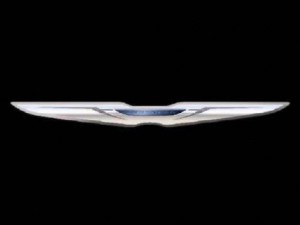
CEO Sergio Marchionne has promised to streamline the automaker starting with this new logo, just approved by the U.S. patent office.
Bankrupt in 2009, back in the black a year later? That’s one of the predictions Sergio Marchionne is expected to make, today, as he lays out his plan to turn around the ailing Chrysler.
Since the smallest of Detroit’s once “Big Three” emerged from Chapter 11, in June, little has been seen or heard about its plans for the future, other than a couple tentative trial balloons.
In part, insiders say that reflects the mess that Chrysler’s new masters at Fiat discovered when they began digging into the company’s current situation.
But the Canadian-educated Fiat CEO Marchionne, who’s now taken the helm at Chrysler, believes that he can begin a lightning turnaround by slicing-and-dicing the U.S. maker’s product line-up – which will mean returning an Italian brand, Alfa-Romeo, to the U.S,, along with select products from Fiat – and implementing Fiat processes to not only speed up product development but also to cut costs and improve quality.
At least 300 people are expected to attend today’s briefing at the Chrysler Technology Center, in Auburn Hills, Michigan. The sprawling facility, with its attached corporate headquarters tower, is both a monument to Chrysler’s past days of glory, as well as a testament to its recent near fatal problems.
Large chunks of the CTC are now empty, victim to the massive cost-cuts ordered while Chrysler was married to Germany’s Daimler and then sold in a fire sale to the private equity giant Cerberus Capital Management. Marchionne reportedly was stunned to discover that much of Chrysler’s once formidable engineering prowess has vanished, making it nearly impossible for the automaker to develop a competitive product line-up on its own.
In a sense, that now provides the tough-minded businessman an opportunity. Rather than force his own team and business model onto an existing bureaucracy, Fiat will have the opportunity to rebuild Chrysler nearly from scratch.
Among other things, Marchionne is expected to announce a goal of trimming the average product development time from three years to as little as 18 months. One way to achieve that will be to use fewer product platforms, and many, though clearly not all, will be shared with the various Fiat brands.
Fixing quality will be one of the biggest challenges to face the “new” Chrysler. According to a report released last week by the influential Consumer Reports magazine, the U.S. maker’s three brands – Chrysler, Dodge and Jeep – were among the four worst in its annual owner survey of quality and reliability. Studies by J.D. Power and Associates and other independent quality arbiters show similarly dismal results. And a recent recall for front wheels falling off, literally, demonstrates how shaky some of its suppliers are.
Fiat was in a similar situation, not all that many years ago. But since the 57-year-old Marchionne came onboard, the Italian maker has seen quality steadily improve to the point it is considered at par with or better than other major European brands such as Volkswagen.
Ironically, this is Fiat’s second shot at taking over Chrysler. The European maker nearly completed a merger that was expected to put it in charge, two decades ago. Though that deal was supported by then-Chrysler CEO Lee Iacocca, his top lieutenant, Bob Lutz – now General Motors’ Vice Chairman – helped scuttle the marriage hours before it was to be announced.
This time, Chrysler had little choice but accept the coup. Late last year, former CEO Bob Nardelli joined his Big Three colleagues in going to Washington begging for a bailout. Ultimately, Ford Motor Co. CEO Alan Mulally abandoned the idea, but outgoing President Bush approved money to keep Chrysler and GM going, at least temporarily.
Though the new president, Barack Obama, remained open to pumping in still more cash, he announced, on March 31st, that Chrysler had not been able to make a case for surviving on its own. The automaker was effectively forced into bankruptcy and told that if it hoped to re-emerge, it would need to form an alliance with Fiat.
Upon exiting Chapter 11, Chrysler was given billions in additional government aid, the Treasury Department taking a 10% stake in the maker. But Fiat was given a controlling interest and told it could eventually boost its stake to 35% by meeting several goals. That includes expanding Chrysler’s global footprint – critical to reduce the oft-troubled company’s dependence upon the core North American market.
Fiat must also add new fuel-efficient products to the Chrysler line-up to comply, which is one of the reasons why Marchionne is expected to confirm that the U.S. maker will get a new version of the pint-sized Fiat Cinquicento, or 500, a minicar that has won numerous European awards since it was redesigned several years ago.
Other Fiat products will likely join the Chrysler line-up and, meanwhile, the Italian maker is expected to seize the opportunity to re-launch its upscale Alfa-Romeo brand in North America, a market it abandoned two decades ago – a move it has regretted ever since.
How much the basic Chrysler line-up will shift should become clear by the end of the day. Despite passenger car offerings like the once-popular 300 sedan, Chrysler has depended upon minivans, pickups and other light trucks for about two-thirds of its sales. Despite those who’d like to see a switch back to more fuel-efficient passenger car models, Marchionne won’t order a wholesale switch. The Ram pickup will remain, though one minivan model and some slow-selling Jeep offerings may be dropped.
A much-needed remake of the flagship Jeep Grand Cherokee will remain a high priority for the new CEO, as will the launch of the next-generation Chrysler 300.
What’s certain is that Marchionne will be working with a much smaller company than even what emerged following Chrysler’s disastrous marriage to Daimler. Sales and market share have steadily fallen, with the automaker one of the very few to post a decline for October, the first month in several years when even GM was able to report a year-over-year increase.
Marchionne is expected to say the new Chrysler will be able to not only survive but thrive with an 8% market share, about half its peak in recent decades – and also about half what Toyota now holds in the U.S. market.
The executive also is likely to forecast a small profit in 2010. Of course, that will depend upon the uncertainties of the American auto market, which is suffering one of its worst slumps since the Great Depression. But the goal is aided by Chrysler’s vastly scaled-down cost structure – helped, in turn, by billions of dollars in concessions from its U.S. and Canadian labor unions.
Marchionne won’t have much room to slip. The company still has the government looking over its shoulder – and won’t be getting any more money from Washington. If anything, the General Accounting Office, in a new report, concludes it is highly unlikely the Treasury will recover the full investment it has made in Chrysler.
But most importantly, Chrysler has to rebuild the trust of the American motoring public, and that will require fast action on its product line.
No wonder so many folks will be waiting to see what Marchionne has to say today.

